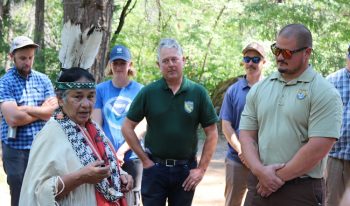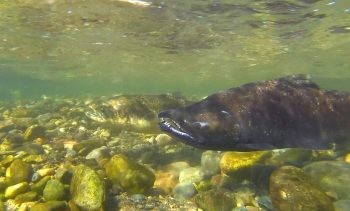New Actions for Recovery of Endangered Winter-Run Chinook Salmon
For the first time since the construction of the Shasta Dam in the 1940s, endangered winter-run Chinook salmon have returned to the McCloud River upstream of Shasta Reservoir by way of egg release from a cohort of partners─ the Winnemem Wintu Tribe, the California Department of Fish and Wildlife (CDFW), the National Oceanic and Atmospheric Administration (NOAA) Fisheries, and the U.S. Fish and Wildlife Service (USFWS).
According to a news release from CDFW, “the partners collected approximately 20,000 fertilized winter-run Chinook salmon eggs from USFWS’ Livingston Stone National Fish Hatchery near Redding and drove them more than three hours over 80 miles to the Ah-Di-Na Campground within the Shasta-Trinity National Forest on the banks of the McCloud River. The eggs were placed into specialized incubators alongside the McCloud River’s cold waters where the species once spawned. Another 20,000 eggs will be transferred to the incubators in the McCloud River in early August. Both cohorts will be released into the river as fry. Rotary screw traps in the river will collect the salmon fry, which will then be transported downstream of Shasta Dam and released to the Sacramento River to migrate to the Pacific Ocean.”

Photo from CDFW.
The Winnemem Wintu Tribe is celebrating this return of winter-run Chinook salmon eggs to the McCloud River, part of their ancestral lands. The Tribe has long sought to return this species back home to the McCloud. We applaud the Winnemem Wintu Tribe, plus their partners in this endeavor: NMFS, CDFW, and USFWS. This is a great collaborative effort by all parties.
This egg release is an emergency and interim measure responding to the critical drought period. CDFW states that “it is not a species reintroduction program. The drought action, however, is expected to inform future long-term recovery and reintroduction efforts as biologists learn how the species uses its historical habitat.”
Two-way trap and haul programs are a controversial recovery strategy with few, if any, programs exhibiting unambiguous success. Research conducted by Dr. Robert Lusardi, the California Trout-UC Davis Wild and Coldwater Fish Scientist, and Dr. Peter Moyle, Associate Director of UC Davis Center for Watershed Sciences, found that two-way trap and haul strategies have a number of uncertainties associated with them. The scientists recommend using extreme caution when employing such methods and clearly defining measureable success criteria. The researchers also recommend that when using this strategy that it be executed in parallel with long-term comprehensive conservation strategies that consider the entire life cycle of the species. (For more, read their recommendations and review in Fisheries, “Two-Way Trap and Haul as a Conservation Strategy for Anadromous Salmonids.”)

Chinook salmon. By Mike Wier.
On-the-ground restoration projects to benefit winter-run and their habitat are also very critical for their recovery. The historical spawning habitats for winter-run Chinook salmon are limited to the upper Sacramento River, McCloud River, Pit River, and Battle Creek. Unfortunately, the consistent year-round streamflow that supported the evolution of winter-run also led to its exploitation through the development of dams and hydropower that lack fish passage facilities. The source waters that historically provided spawning habitat are now completely blocked behind impassible dams such as Keswick Dam and the Battle Creek Hydroelectric Project.
CalTrout and our partners are actively working on the Battle Creek – Eagle Canyon Fish Passage Project, completing construction last year on a rock barrier in Eagle Canyon, resolving the largest fish passage barrier in the North Fork of Battle Creek which reconnected miles of anadromous salmonid habitat. This project was a huge step toward reconnecting winter-run Chinook salmon with their historical habitats. Eagle Canyon is just one of a host of major projects that are on the horizon in Battle Creek and represent the best opportunities for on the ground restoration to conserve and recover this member of California’s biodiversity. CalTrout and our partners are stepping up to do what we can to help, and we are currently working toward another large-scale passage project to continue the momentum: the decommissioning and removal of the dams that make up the Battle Creek Hydroelectric Project. This restoration project and others within the Battle Creek watershed are crucial to the recovery and securing a stronghold of winter-run Chinook salmon above and below Shasta Dam. (Learn more about CalTrout’s work at Battle Creek by watching our video.)
Cover photo: juvenile Chinook salmon, taken by Mike Wier.





